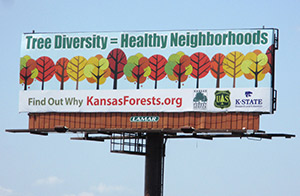Tree diversity equals healthy neighborhoods
Planting a variety of trees in neighborhoods and communities can help combat canopy loss.
Oct. 8, 2015
 MANHATTAN, Kan. – The Kansas Forest Service has partnered with Heartland Tree Alliance, the Unified Government of Wyandotte County and Kansas City, Kansas, K-State Research and Extension, Westar Energy Green Team and the U.S. Department of Agriculture Forest Service to plant diverse species of trees at three public locations in Kansas City in the month of October. The sites include Schlagle Library and Waterway Park in Kansas City, Kansas, and Windsor Park in Prairie Village, Kansas.
MANHATTAN, Kan. – The Kansas Forest Service has partnered with Heartland Tree Alliance, the Unified Government of Wyandotte County and Kansas City, Kansas, K-State Research and Extension, Westar Energy Green Team and the U.S. Department of Agriculture Forest Service to plant diverse species of trees at three public locations in Kansas City in the month of October. The sites include Schlagle Library and Waterway Park in Kansas City, Kansas, and Windsor Park in Prairie Village, Kansas.
The purpose of the project is to encourage planting different kinds of trees by showing the public examples of what these trees look like. Along a marked walking trail, signage at each tree provides the scientific name and its mature height and spread.
"People tend to stick with what is familiar and most comfortable to them," said Kim Bomberger, district community forester with the Kansas Forest Service. "They choose landscape plants and trees by the names they recognize, like Bradford pear, maple, pampas grass, rose or oak. However, this is not a wise approach given the insect and disease threats and severe weather that affect trees in Kansas."
Planting only one species of tree in a community can be disastrous when disease hits. Since the 1950s, Dutch elm disease has killed millions of American elm trees. Scotch and Austrian pines have been severely damaged by pine wilt since the late 1970s.
Most recently, hundreds of millions of ash trees across the eastern U.S. have been devastated. "The emerald ash borer is now considered the most destructive forest pest ever seen in North America," said Deborah McCullough, entomology professor at Michigan State University.
According to the Kansas Department of Agriculture, the emerald ash borer was first detected in Wyandotte County, Kansas, in 2012, and has now been confirmed in Johnson and Leavenworth counties. This wood-boring insect attacks and kills all species of North American ash and can be especially ruinous where a monoculture of ash has been planted in towns and landscapes.
While insects and disease can devastate a population of trees comprised of one species, severe storm events can also be a threat. Silver maple, hackberry, Siberian elm, cottonwood, Bradford pear and ash are particularly susceptible to high winds.
The Kansas Forest Service recommends choosing a wide array of tree species for planting in your home landscape and community. To learn which trees will fit best in your area, visit http://www.kansasforests.org/resources. To see locations of where you can view tree specimens, see the arboretum map at http://www.kansasforests.org/events/diversity.html.
-30-
K-State Research and Extension is a short name for the Kansas State University Agricultural Experiment Station and Cooperative Extension Service, a program designed to generate and distribute useful knowledge for the well-being of Kansans. Supported by county, state, federal and private funds, the program has county Extension offices, experiment fields, area Extension offices and regional research centers statewide. Its headquarters is on the K-State campus, Manhattan.
Story by:
Jennifer Williams
Kansas Forest Service
jgwilliams@ksu.edu
785-532-3308
For more information:
Kim Bomberger – kbomberg@ksu.edu or 785-532-3315
